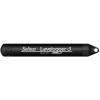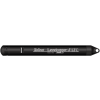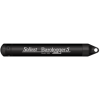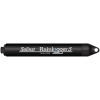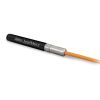Solinst Levelogger 5 App Interface
Features
- Communicate to Leveloggers wirelessly
- Eliminate the need to bring a laptop to the field
- View real-time readings, or download and e-mail logged data files
- Free ground shipping
- Expedited repair and warranty service
- Lifetime technical support
- More
Overviw
The Solinst Levelogger 5 App Interface for the Levelogger Series uses Bluetooth® wireless technology to connect a Solinst datalogger to an Apple® or Android™ smart device. Once connected, the user can view data and program the datalogger using the Levelogger App. The App Interface is compatible with Levelogger’s Direct Read Cable or Adaptor, LevelVent Wellhead, or AquaVent Wellhead Connector Cable.
Mechanics
The App Interface is compact in design, and is easily transported. It uses four 1.5V AA lithium batteries that are easily replaced. The Interface has a power button to turn it on and off, and there is an auto-off after 10 minutes of inactivity. A LED light indicates its status.
*Note: The Bluetooth® word mark and logos are registered trademarks owned by Bluetooth SIG, Inc. and any use of such marks by Solinst Canada Ltd. is under license.
®Apple is a trademark of Apple Inc., registered in the U.S. and other countries. App Store is a service mark of Apple Inc. iOS is a trademark or registered trademark of Cisco in the U.S. and other countries and is used under license.
Android is a trademark of Google Inc.
- Compatibility: Levelogger 5 Series dataloggers, LevelVent 5 and AquaVent 5, as well as previous versions of the LevelVent and AquaVent, and Levelogger Edge Series dataloggers
- IP Rating: IP64 (dust and splash resistant)
- Materials: Black Delrin, 316 stainless steel
- Operating Temperature: -20 C to + 50 C
- Batteries: 4 x 1.5V AA replaceable lithium batteries
- Battery Life: 500 full Levelogger downloads @ 21 C
- Size: 2.25" (57mm) diameter x 4.875" (124mm) length
- Weight: 13.7 oz. (388g)
In The News
Data-Driven Advocacy on the Lower Deschutes River
Like many freshwater environments, the Deschutes River in Oregon is under pressure from development, pollution, and climate change. Many rivers, streams and lakes in the Deschutes Basin do not meet Oregon water quality standards –where state water quality monitoring assesses levels of bacteria, pH, dissolved oxygen, temperature, and fine sediment. Hannah Camel is the Water Quality Coordinator for the Deschutes River Alliance (DRA), a non-profit organization that focuses on the health of the lower 100 miles of the Deschutes River–the area most affected by human intervention. As a data-driven organization, the DRA has benefited from the installation of two NexSens X2 data loggers.
Read MoreExpanding the Port Everglades: Real-Time Monitoring of Water Quality Conditions from Planned Dredging Operation
The Port Everglades in Broward County, Florida, serves large trade vessels and cruiseliners and incoming and outgoing recreational boaters. However, as cargo ships become larger, the port must expand. A dredging project led by the US Army Corps of Engineers will substantially deepen and widen the port's navigation channel to accommodate larger Panamax cargo ships and modern cruise liners. As a result of this project, a large amount of sediment will be displaced into the water column. This suspended sediment may settle outside of the project area, burying benthic organisms like corals, and possibly carrying harmful particulates to other regions. [caption id="attachment_39497" align="aligncenter" width="2560"] A CB-950 and CB-25 deployed on site at Port Everglades.
Read MoreIt’s Time to React to Water Quality: Proteus Multiparameter Probe aboard NexSens Buoy
Water quality monitoring is essential for safeguarding public health, protecting ecosystems, and ensuring the sustainability of water resources. Contaminants such as industrial pollutants, agricultural runoff, and sewage discharge can severely impact aquatic life and pose serious risks to human health if left unchecked. Traditionally, water quality monitoring has been a slow and labor-intensive process, requiring samples to be collected, transported to a lab, and analyzed—a process that can take days. However, with the advancement of real-time sensor technology, environmental agencies, researchers, and industries can now monitor water quality instantly.
Read More












